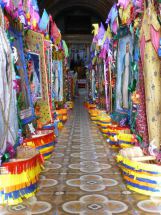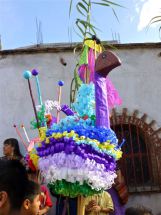Mexican Folk Art Christmas Tree Decorations
Posted: November 20, 2013 Filed under: Christmas, Folk Art, Mexican Crafts, Mexican Folk Art, Mexican Holidays, Navidad, Oaxaca, Tin | Tags: Celebrate the holidays, Christmas, handmade, Mexican crafts, Mexican folk art, Navidad, Tin, Wood Carvings Comments Off on Mexican Folk Art Christmas Tree DecorationsIt’s early, I know, but people are already buying Christmas tree ornaments in the Minneapolis shop! We have some very unique decorations and some of them are online. They are all handmade. That means they were not made by the millions by a machine. No, they were actually designed and made by hand, painted by hand and have all of the charm of bigger pieces of Mexican folk art but in a smaller size. And they come from different cities and artisans all over Mexico. Click on the photo to take you to the online shop!
 Wood carved animalitos from La Union, Oaxaca.
Wood carved animalitos from La Union, Oaxaca.
 Cute lacquered airplanes and pilots as a Mexican Christmas ornament handmade in Guerrero.
Cute lacquered airplanes and pilots as a Mexican Christmas ornament handmade in Guerrero.
 The star-shaped pinata shows up everywhere in Mexico during the Christmas season. These small straw pinatas decorated with yarn are pretty individually or linked together in a chain.
The star-shaped pinata shows up everywhere in Mexico during the Christmas season. These small straw pinatas decorated with yarn are pretty individually or linked together in a chain.
 Festive and colorful woven palm leaf Christmas ornaments. These come in a cluster of 12 and can be separated or left together.
Festive and colorful woven palm leaf Christmas ornaments. These come in a cluster of 12 and can be separated or left together.
 Beautiful tin musicians from Oaxaca, Mexico. These are 9″ tall and beautifully made. Unique.
Beautiful tin musicians from Oaxaca, Mexico. These are 9″ tall and beautifully made. Unique.
Have a question? Send us an email…
Let the festivities begin! | View From Casita Colibrí
Posted: July 11, 2013 Filed under: Folk Art, Mexican Crafts, Mexican Folk Art, Mexican Holidays, Mexico, Oaxaca, Paper Folk Art, Virgin of Guadalupe | Tags: handmade, Mexican crafts, Mexican folk art, Mexican holidays, Oaxaca, paper folk art, Virgin of Guadalupe 2 CommentsSunday in Tlacolula
Let the festivities begin!
July 11, 2013 by spixl
Monday, we returned to Teotitlán del Valle for the Fiesta titular a la Preciosa Sangre de Nuestro Señor Jesucristo — the pueblo’s most important festival of the year. While special masses have been celebrated at the Templo de la Preciosa Sangre de Cristo (the village church) since June 30, Monday’s convite (procession) by the unmarried women in the village, kicked off the more public events.
Lovingly decorated canastas (baskets) waited in the church to be reclaimed by their owners, placed on their heads, and carried through the streets.
Crowds gathered in the plaza in front of the church and sidewalks and streets along the route. And then it began — with solemn drum beats, fireworks, church bells, marmotas (cloth balloons on a pole), and a band.
Little boys (and a few girls) carrying model airplanes (don’t ask me why), paper mache lambs, and turkeys followed.
And then came the neatly organized rows of girls and young women.For over an hour they wound their way up and down and around the streets of Teotitlán del Valle. The weather was perfect, no late afternoon thunder showers this year, and it was glorious.
Stay tuned, the festivities continue all week. And, check out Oaxaca-The Year After this week for blogger buddy Chris’s photos and commentary.
via Let the festivities begin! | View From Casita Colibrí.
Mexican Weaving with Natural Palma or Raffia Fibers
Posted: April 1, 2013 Filed under: Mexican Crafts, Mexican Folk Art, Oaxaca, Palma, Weaving | Tags: handmade, Mexican Baskets, Mexican crafts, Mexican folk art, Palma Comments Off on Mexican Weaving with Natural Palma or Raffia Fibers
More Mexican Folk Art Wood Carvings from Oaxaca
Posted: January 10, 2013 Filed under: Folk Art, Masks, Mexican Style, Oaxaca, Wood Carvings | Tags: Folk Art, handmade, Mexican crafts, Mexican folk art, Oaxaca, Wood Carvings Comments Off on More Mexican Folk Art Wood Carvings from OaxacaOne of the popular arts for which Mexico is most famous is the wood carvings of Oaxaca. In fact, if people only know one thing about folk art from Mexico, it’s usually about the wood carvings or “alebrijes” which they’ve seen at the beach resorts or airports of coastal Mexico.
The carving of masks and children’s toys in the Oaxaca area dates back hundreds, if not thousands of years, but the current expression of wood carvers in Oaxaca’s surrounding villages was started in the small town of Arrazola by Manuel Jiménez in the late 1950’s. Now, three tiny villages –Arrazola, San Martin Tilcajete, and La Union–are known for their carvings and carvers. The lives of these artisans are not easy. Oaxaca is one of the poorest states in Mexico and most of the carvers living in these villages are subsistence farmers and carve their beautiful pieces for extra income.
A few carvers have done exceedingly well and are world-renowned. This is true for Jacobo Angeles whose amazing work can take months to complete. He employs many, many family members in his lovely home in San Martin Tilcajete. His taste and ability are exquisite and his carvings are highly regarded and highly sought after. We carry the beautiful carved hummingbirds as seen below:
Jacobo’s sister, Roberta, carved this stunning nativity set and it too is exceptional in its concept and execution. Truly a unique and collectible piece.
There are many, many very skilled carvers in Oaxaca and I wish I could feature all of them. I plan to feature others in the days ahead.
Today, I want to recommend a couple of carving families in addition to the familia Angeles, and those are first, Flor and Abad Xuana and second, Aurelia and Juventino Melchor. In both of these families, the man does the carving and the woman does the painting. And in both cases, each person is an artist extraordinaire!
I’ve carried the carvings of the Xuanas before and they will always be some of my favorites. Flor is one of the tiniest people I’ve ever met and one of the most lovely. This photo was taken at the Day of the Dead show in Oaxaca.
Here are some of the lovely pieces that I purchased from Flor and are now available at Zinnia Folk Arts.
The duck, white bird and woodpecker are exceptionally beautiful. You can click on the photos for more info and details.
There is another couple from San Martin Tilcajete who does very nice work. They are named, Juventino and Aurelia Melchor. I especially fell in love with their bunnies and have quite a few of them in the shop. Here are two in the website shop…
For more information about Oaxacan wood carving and carvers as well as the inevitable politics of it all, you can read, Oaxacan Woodcarving by Shepard Barbash (1993). Another writer is Michael Chibnick and his book is Crafting Tradition: The Making and Marketing of Oaxacan Wood Carvings.
As always, if you have any questions, please ask!
Teodora Blanco, Master Artist from Atzompa, Oaxaca, Mexico
Posted: August 11, 2012 Filed under: Clay Ceramics, Mexican Crafts, Mexican Folk Art, Oaxaca | Tags: Ceramics, handmade, Mexican ceramics, Mexican crafts, Mexican folk art, Oaxaca, pastillaje Comments Off on Teodora Blanco, Master Artist from Atzompa, Oaxaca, MexicoThe unpainted doll clay work of Teodora Blanco, who died in 1980, was an original in the history of Mexican folk art. She was well known while alive for creating the beautifully embellished clay “munecas” (dolls) representing Mexican women doing daily activities OR fantastic human-ish figures topped with animal heads and horns. Her unique and influential work was collected by Nelson Rockefeller and she was one of, if not the first, Mexican clay artisan to decorate her unpainted clay figures with “pastillaje” or attached decorative pieces of clay. Her exceptionally skilled children, Luis and Irma, continue her tradition today. We have numerous signed (TB) Teodora pieces acquired through an estate sale. We also have several pieces by Irma Blanco. Feel free to call or email with questions!
Wood Carvings from Oaxaca
Posted: February 15, 2012 Filed under: Mexican Folk Art, Oaxaca, Wood Carvings | Tags: handmade, Mexican folk art, Oaxaca, oaxacan carvings, Wood Carvings Comments Off on Wood Carvings from Oaxaca
Generally, when the subject of folk art from Mexico comes up, people usually think of the wood carvings of Oaxaca. These colorful little ambassadors have become world-renowned as representative of Mexico and can literally be found almost everywhere. They have so saturated the thinking of what is Mexican folk art that it can be difficult to pull people away to see that the handmade arts of Mexico encompass so much more.
Did you know that this carving is from Oaxaca? No? Sadly, when one says, “wood carvings of Mexico” the carvings of artisans from the Oaxaca area bring to mind multi-colorful, overpainted, roosters with toothpicks sticking out of their backs. They come in many colors and are mostly animals with bright colors and lots of dots. Or fantastic creatures called, “alebrijes” which I’ve always found unappealing.
The Oaxacan carvings we carry at Zinnia Folk Arts are somewhat different. We prefer the more rustic carving style. This more primitive (less decorated) style comes from the tiny town of La Union, Oaxaca. Many of the carvings we carry are by the Santiago family. The pineapple lady above was carved by Eloy Santiago, and the cart below by his cousin.
The colorful musicians are another example of the more rustic style.
Another town in Oaxaca, known for its woodcarvers, is San Martin Tilcajete. And these styles, below, (hummingbird by Angeles family and tiny masks by Xuana family) are more indicative of the aesthetic in that town.
Which style do you prefer?



























